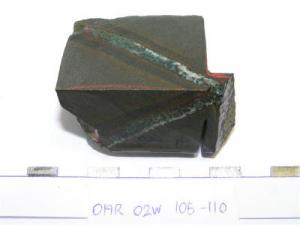|

|
|
Calcium carbonate veins are common in upper ocean crust, where they precipitate from low temperature (<100 C) seawater-derived hydrothermal fluids that have reacted with the basaltic lavas that form the ocean floor. These fluids are modified by chemical exchange with the ocean crust as they heat up. The veins precipitate from the basement fluid at compositions that have evolved away from that of the initial seawater, but from analyses of suites of these veins the chemistry of seawater at that time can be estimated.
[Credit: Christopher Smith-Duque, NOCS]
|
"Reconstructing past ocean chemistry remains a major challenge for Earth scientists, but small calcium carbonate veins formed from warm seawater when it reacts with basalts from the oceanic crust provide a unique opportunity to develop such records," added co-author Professor Damon Teagle from SOES. Calcium carbonate veins record the chemical evolution of seawater as it flows through the ocean crust and reacts with the rock. The composition of past seawater can therefore be determined from suites of calcium carbonate veins that precipitated millions of years ago in ancient ocean crust. The researchers reconstructed records of the ratios of strontium to calcium (Sr/Ca) and magnesium to calcium (Mg/Ca) over the last 170 million years. To do this, they analysed calcium carbonate veins from basaltic rocks recovered by several decades of scientific deep-ocean drilling by the Integrated Ocean Drilling Program (IODP) and its predecessors. "The carbonate veins indicate that both the Sr/Ca and Mg/Ca ratios of seawater were significantly lower than at present prior to about 25 million years ago. We attribute the increases in seawater Sr/Ca and Mg/Ca since then to the long-term effects of decreased seafloor volcanism and the consequent reduction in chemical exchange between seawater and the ocean crust," said Professor Teagle. The research was supported by the United Kingdom's Natural Environment Research Council and used samples provided by the Ocean Drilling Program (ODP) and Integrated Ocean Drilling Program (IODP). ODP was sponsored by the US National Science Foundation (NSF) and participating countries under management of Joint Oceanographic Institutions Inc. IODP is supported by NSF; Japan's MEXT; ECORD; and the People's Republic of China, Ministry of Science and Technology. The National Oceanography Centre, Southampton is the UK's focus for ocean science. It is one of the world's leading institutions devoted to research, teaching and technology development in ocean and Earth science. Over 500 scientists, support and seagoing staff are based at the centre's purpose-built waterside campus in Southampton along with over 700 undergraduate and postgraduate students.
|